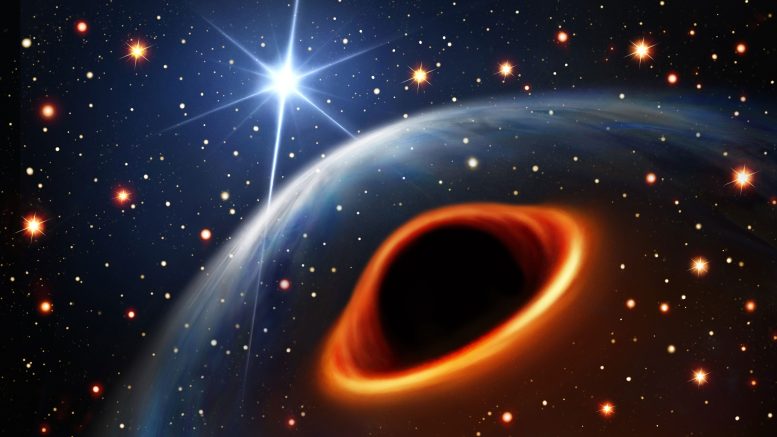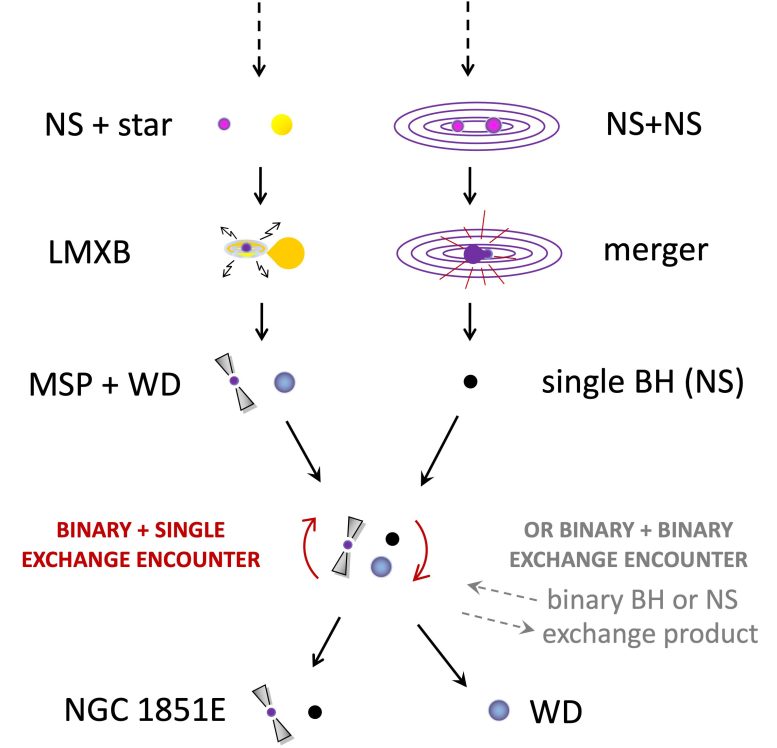
An artist’s impression of the system assuming that the massive companion star is a black hole. The brightest background star is its orbital companion, the radio pulsar PSR J0514-4002E. The two stars are separated by 8 million km and circle each other every 7 days. Credit: Daniëlle Futselaar (artsource.nl)
Using the MeerKAT Telescope, astronomers found a mysterious object in the Milky Way’s black hole mass gap, challenging existing astronomical classifications and offering a unique opportunity to study the universe’s most extreme conditions.
An international team of astronomers has found a new and unknown object in the Milky Way that is heavier than the heaviest neutron stars known and yet simultaneously lighter than the lightest black holes known.
Using the MeerKAT Radio Telescope, astronomers from a number of institutions including The University of Manchester and the Max Planck Institute for Radio Astronomy in Germany found an object in orbit around a rapidly spinning millisecond pulsar located around 40,000 light-years away in a dense group of stars known as a globular cluster.
A Gap in the Mass Spectrum
Using the clock-like ticks from the millisecond pulsar they showed that the massive object lies in the so-called black hole mass gap.
It could be the first discovery of the much-coveted radio pulsar – black hole binary; a stellar pairing that could allow new tests of Einstein’s general relativity and open doors to the study of black holes.
The results were published on January 18 in the journal Science.

The team used the sensitive MeerKAT radio telescope, located in the Karoo semi-desert in South Africa. Credit: SARAO
Implications for Physics and Astronomy
UK project lead Ben Stappers, Professor of Astrophysics at The University of Manchester, said: “Either possibility for the nature of the companion is exciting. A pulsar–black hole system will be an important target for testing theories of gravity and a heavy neutron star will provide new insights in nuclear physics at very high densities.”
When a neutron star — the ultra-dense remains of dead star – acquire too much mass, usually by consuming or colliding with another star, they will collapse. What they become after they collapse is the cause of much speculation, but it is believed that they could become black holes – objects so gravitationally attractive that even light cannot escape them.
Astronomers believe that the total mass required for a neutron star to collapse is 2.2 times the mass of the sun. Theory, backed by observation, tells us that the lightest black holes created by these stars are much larger, at about five times more massive than the Sun, giving rise to what is known as the ‘black hole mass gap’.
The nature of compact objects in this mass gap is unknown and detailed study has so far proved challenging. The discovery of the object may help finally understand these objects.
Prof Stappers, added: “The ability of the extremely sensitive MeerKAT telescope to reveal and study these objects is enabling a great step forward and provides us with a glimpse of what will be possible with the Square Kilometer Array.”
A zoom into the globular cluster NGC 1851 followed by an orbital simulation showing the original pulsar – white dwarf binary being disrupted by the arrival of a massive third body of unknown nature. The new arrival kicks the white dwarf out of orbit and captures the pulsar for itself, forming a new binary system with a pulsar in orbit around, most likely, either a light black hole or a supermassive neutron star. Credit: OzGrav, Swinburne University of Technology
The Discovery Process
The discovery of the object was made while observing a large cluster of stars known as NGC 1851 located in the southern constellation of Columba, using the MeerKAT telescope.
The globular cluster NGC 1851 is a dense collection of old stars that are much more tightly packed than the stars in the rest of the Galaxy. Here, it is so crowded that the stars can interact with each other, disrupting orbits and in the most extreme cases colliding.
The astronomers, part of the international Transients and Pulsars with MeerKAT (TRAPUM) collaboration, believe that it is one such collision between two neutron stars that is proposed to have created the massive object that now orbits the radio pulsar.
The team was able to detect faint pulses from one of the stars, identifying it as a radio pulsar — a type of neutron star that spins rapidly and shines beams of radio light into the Universe like a cosmic lighthouse.
The pulsar spins more than 170 times a second, with every rotation producing a rhythmic pulse, like the ticking of a clock. The ticking of these pulses is incredibly regular and by observing how the times of the ticks change, using a technique called pulsar timing, they were able to make extremely precise measurements of its orbital motion.

Potential formation history of the radio pulsar NGC 1851E and its exotic companion star. Credit: Thomas Tauris (Aalborg University / MPIfR)
Unveiling Extreme Conditions
Ewan Barr from Max Planck Institute for Radio Astronomy, who led the study with his colleague Arunima Dutta, explained: “Think of it like being able to drop an almost perfect stopwatch into orbit around a star almost 40,000 light years away and then being able to time those orbits with microsecond precision.”
The regular timing also allowed a very precise measurement of the system’s location, showing that the object in orbit with the pulsar was no regular star but an extremely dense remnant of a collapsed star. Observations also showed that the companion has a mass that was simultaneously bigger than that of any known neutron star and yet smaller than that of any known black hole, placing it squarely in the black-hole mass gap.
While the team cannot conclusively say whether they have discovered the most massive neutron star known, the lightest black hole known, or even some new exotic star variant, what is certain is that they have uncovered a unique laboratory for probing the properties of matter under the most extreme conditions in the Universe.
Arunima Dutta concludes: “We’re not done with this system yet.
“Uncovering the true nature of the companion will be a turning point in our understanding of neutron stars, black holes, and whatever else might be lurking in the black hole mass gap.”
Reference: “A pulsar in a binary with a compact object in the mass gap between neutron stars and black holes” by Ewan D. Barr, Arunima Dutta, Paulo C. C. Freire, Mario Cadelano, Tasha Gautam, Michael Kramer, Cristina Pallanca, Scott M. Ransom, Alessandro Ridolfi, Benjamin W. Stappers, Thomas M. Tauris, Vivek Venkatraman Krishnan, Norbert Wex, Matthew Bailes, Jan Behrend, Sarah Buchner, Marta Burgay, Weiwei Chen, David J. Champion, C.-H. Rosie Chen, Alessandro Corongiu, Marisa Geyer, Y. P. Men, Prajwal Voraganti Padmanabh and Andrea Possenti, 18 January 2024, Science.
DOI: 10.1126/science.adg3005
>>> Read full article>>>
Copyright for syndicated content belongs to the linked Source : SciTechDaily – https://scitechdaily.com/einsteins-enigma-how-a-mysterious-cosmic-object-in-milky-way-could-test-relativity-like-never-before/































